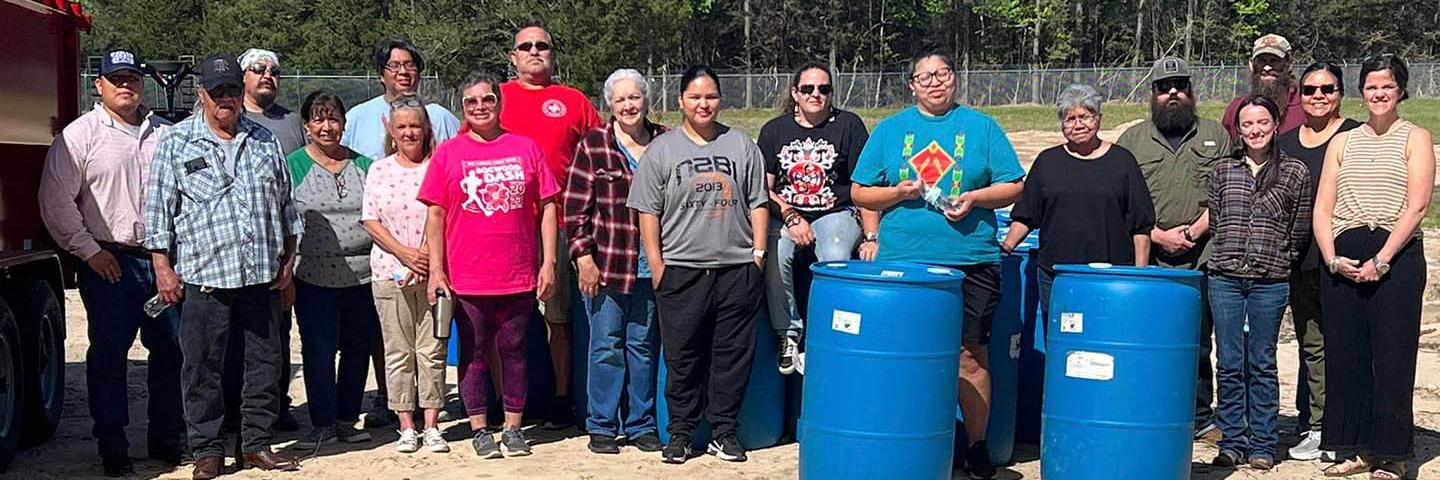A Federal-tribal partnership is helping support tribal values and build climate-change resilient communities with an ancient conservation practice. The Alabama-Coushatta Tribe of Texas adopted an ancient conservation practice to solve a modern-day problem.
A Federal-tribal partnership is helping support tribal values and build climate-change resilient communities with an ancient conservation practice.
The Alabama-Coushatta Tribe of Texas adopted an ancient conservation practice to solve a modern-day problem. Tribal members teamed up with the U.S. Department of Agriculture’s (USDA) Southern Plains Climate Hub (SPCH) and the Department of the Interior’s Bureau of Indian Affairs (BIA) to learn a unique way to address extreme drought that placed extra strain on area lakes and groundwater levels. The intergovernmental union demonstrates the positive outcomes of a successful partnership that benefited members of the tribe.
To help address the lack of water, the BIA and the USDA Natural Resources Conservation Service (NRCS) worked with the tribe to propose a nature-based solution. Rainwater harvesting is the practice of collecting rainwater from a roofed surface, then storing the water for later use. More than 10,000 years ago, the Mescalero Apache tribe used natural rainwater harvesting systems to collect rainwater near today’s city of El Paso, Texas.
In the case of the Alabama-Coushatta Tribe, their 27,500 square foot Veterans Pavilion provided the ideal structure to collect rainwater. The water has been used for many purposes, including irrigation, livestock, wildlife, fire protection, and more.
Texas District Conservationist Jacob Shaffer with NRCS was instrumental in the project’s success. During a nine-month assignment, he worked with the SPCH as the Climate Environmental Tribal Liaison, providing conservation demonstrations and information on rainwater harvesting systems for tribal members. Shaffer helped design six rainwater harvesting systems and assisted with the installation of two. Workshops and field days offered just over 2,400 attendees from historically underserved rural communities information and technical assistance about the rainwater harvesting systems.

Shaffer and partners from BIA hosted hands-on outreach workshops to demonstrate how to construct a simple, yet effective rain barrel. Financial assistance from BIA enabled each participant to depart the workshop with a 55-gallon rain barrel.
“The popularity of harvesting rainwater as a conservation practice is spreading, from Texas to New Mexico and up to Nebraska. Tribal nations have been communicating with each other to share the benefits of the practice,” explains Shaffer.
“This assignment not only allowed me to spread the word about water conservation but also encouraged tribal members to pursue other conservation efforts such as pollinator plantings, brush management, livestock grazing plans, erosion control, and more,” he said.
The Alabama-Coushatta Tribe is no stranger to conservation stewardship. They worked with NRCS to restore the critical and culturally significant longleaf pine ecosystem, a native tree sacred to the tribe and essential to their basket weaving practice.
The Alabama-Coushatta Tribe of Texas has the oldest reservation in the state, encompassing approximately 11,000 acres in the Big Thicket of Deep East Texas (an hour and a half north of Houston). “We average 48 inches of rain yearly, but in recent years we’ve had longer and more intense droughts,” explained Gesse Bullock, Alabama-Coushatta Tribe’s Fire Management Specialist.
Installation involved placement of a system to convey harvested rainwater to a 65,000-gallon water storage tank. “Being able to capture and store all of the water runoff from the pavilion has been very beneficial to the land and the tribe,” said Bullock. As of summer 2024, the water storage facility has collected 75 percent capacity (48,750 gallons) from recent rainfall events.
Bullock said last summer’s drought took a big toll on the reservation’s water infrastructure, and the tribe wanted to find a reliable water source without tapping into the tribal water system. “Our creeks and lake were drying up to a point we have not seen that low in years,” he explained.
The new rainfall harvesting system serves multiple purposes for tribal members. Not only is the water necessary for crops, community gardens, and food production, it is also critical for firefighting, filling water trucks for road construction, managing prescribed fires, and irrigating local gardens. Now the tribe can access the captured rainwater and use it as needed whether in emergency situations or other water conservation efforts.
“This project has benefitted tribal members and conserved a vital natural resource in a way that will serve as a model for many others,” explained NRCS Chief Terry Cosby. He also said that the effort is a great illustration of USDA’s commitment to the Justice40 Initiative, which aims to ensure that 40 percent of the overall benefits of certain climate, clean energy, and other federal investments flow to disadvantaged communities marginalized by underinvestment and overburdened by pollution. “This union between the Alabama-Coushatta Tribe, USDA, and BIA shows what can happen when partners are empowered to create climate-change resilient communities,” said Chief Cosby.




